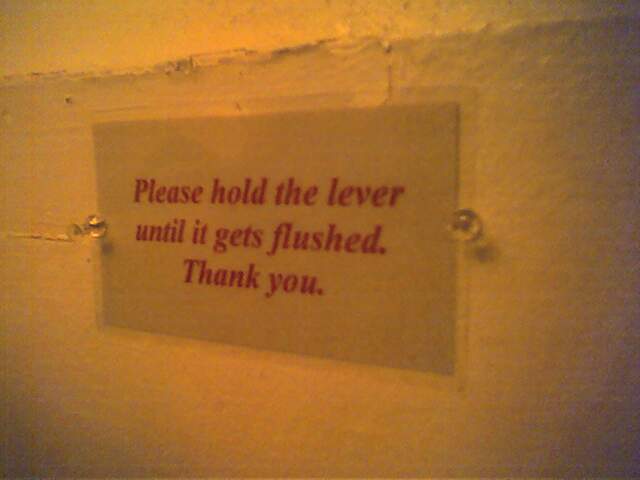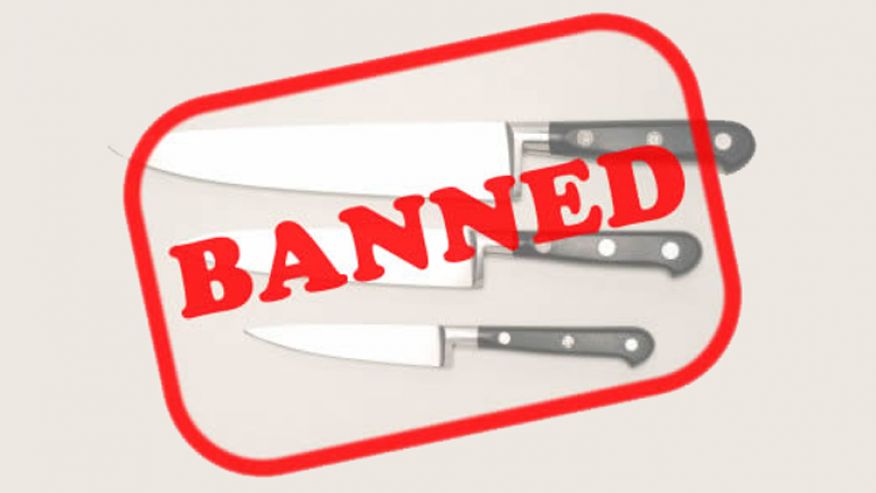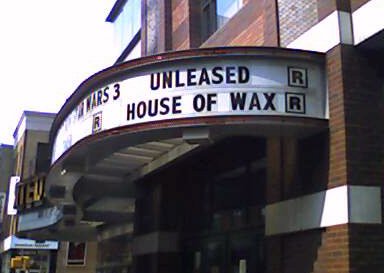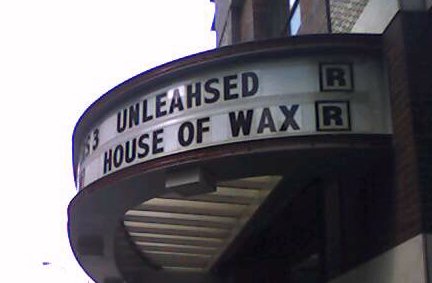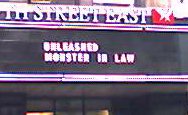Flotsam, jetsam, lagan, and derelict
Long & Pointy
British Medical Experts Campaign for Long, Pointy Knife Control
By JOHN SCHWARTZWarning: Long, pointy knives may be hazardous to your health.
The authors of an editorial in the latest issue of the British Medical Journal have called for knife reform. The editorial, “Reducing knife crime: We need to ban the sale of long, pointed kitchen knives,” notes that the knives are being used to stab people as well as roasts and the odd tin of Spam.
The authors of the essay – Drs. Emma Hern, Will Glazebrook and Mike Beckett of the West Middlesex University Hospital in London – called for laws requiring knife manufacturers to redesign their wares with rounded, blunt tips.
The researchers noted that the rate of violent crime in Britain rose nearly 18 percent from 2003 to 2004, and that in the first two weeks of 2005, 15 killings and 16 nonfatal attacks involved stabbings. In an unusual move for a scholarly work, the researchers cited a January headline from The Daily Express, a London tabloid: “Britain is in the grip of knives terror – third of murder victims are now stabbed to death.” Dr. Hern said that “we came up with the idea and tossed it into the pot” to get people talking about crime reduction. “Whether it’s a sensible solution to this problem or not, I’m not sure.”
In the United States, where people are more likely to debate gun control than knife control, partisans on both sides sounded amused. Wayne LaPierre, executive vice president of the National Rifle Association, asked, “Are they going to have everybody using plastic knives and forks and spoons in their own homes, like they do in airlines?”
Peter Hamm, a spokesman for the Brady Campaign to Prevent Gun Violence, which supports gun control, joked, “Can sharp stick control be far behind?” He said people in his movement were “envious” of England for having such problems. “In America, we can’t even come to an agreement that guns are dangerous and we should make them safer,” he said.
The authors of the editorial argued that the pointed tip is a vestigial feature from less mannered ages, when people used it to spear meat. They said that they interviewed 10 chefs in England, and that “none gave a reason why the long, pointed knife was essential,” though short, pointed knives were useful.
An American chef, however, disagreed with the proposal. “This is yet another sign of the coming apocalypse,” said Anthony Bourdain, the executive chef at Les Halles and the author of “Kitchen Confidential.”
A knife, he said, is a beloved tool of the trade, and not a thing to be shaped by bureaucrats. A chef’s relationship with his knives develops over decades of training and work, he said, adding, “Its weight, its shape – these are all extensions of our arms, and in many ways, our personalities.”
He compared the editorial to efforts to ban unpasteurized cheese. “Where there is no risk,” he said, “there is no pleasure.”
Note, we’re not talking about the usual sorts of “knife control” laws, like not letting kids buy them, or banning certain types of knives (well, I guess in a sense we are talking about banning certain kinds of knives), like switchblades, or gravity blades, or the latest in samurai sword attacks (which seem to be quite common if one does a google search) or things of that sort. This is more in the line of:
“Sharp, pointy objects shouldn’t be available to anyone.” said Sen. Lieberman, D-Conn., a key figure in the knife-control movement.
Wax On, Wax Off
A good story makes the product better
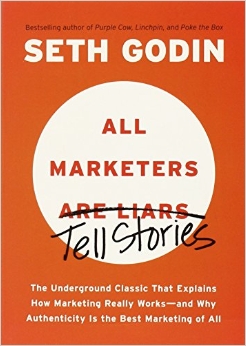 Okay, this isn’t my own, it’s an excerpt from a new book called All Marketers Are Liars by Seth Goldin. The excerpt appeared in the May 2005 issue of Fortune: Small Business, so I’m not sure if it’s exactly what will appear in the final book (to be published this month). But, since it relates to my career, and I liked it, I’m just posting it. By the way, the rest of the excerpt is truly fascinating – look for the book in stores soon!
Okay, this isn’t my own, it’s an excerpt from a new book called All Marketers Are Liars by Seth Goldin. The excerpt appeared in the May 2005 issue of Fortune: Small Business, so I’m not sure if it’s exactly what will appear in the final book (to be published this month). But, since it relates to my career, and I liked it, I’m just posting it. By the way, the rest of the excerpt is truly fascinating – look for the book in stores soon!
Georg Riedel is a fibber—an honest spinner of tales. He tells his customers something that isn’t true—his wineglasses make wine taste better—and then the very act of believing it makes the statement true. Because drinkers believe the wine tastes better, it does taste better.
Georg is a tenth-generation glass blower, an artisan pursuing an age-old craft. I’m told he’s a very nice guy. And he’s very good at telling stories. His company makes wineglasses (also whiskey glasses, espresso glasses, and even water glasses). He and his staff fervently believe that there is a perfect (and different) shape for every beverage. According to Riedel’s website, “The delivery of a wine’s ‘message,’ its bouquet and taste, depends on the form of the glass. It is the responsibility of a glass to convey the wine’s messages in the best manner to the human senses.”
Thomas Matthews, the executive editor of Wine Spectator magazine, said, “Everybody who ventures into a Riedel tasting starts as a skeptic. I did.” The skepticism doesn’t last long. Robert Parker Jr., the king of wine reviewers, said, “The finest glasses for both technical and hedonistic purposes are those made by Riedel. The effect of these glasses on fine wine is profound. I cannot emphasize enough what a difference they make.” Parker and Matthews and hundreds of other wine luminaries are now believers (and as a result, they are Riedel’s best word-of-mouth marketers). Millions of wine drinkers around the world have been persuaded that a $200 bottle of Opus One (or a bottle of Two-Buck Chuck) tastes better when served in the proper Riedel glass.
Yet when tests are done scientifically—double-blind tests that eliminate any chance that the subject would know the shape of the glass—there is absolutely zero detectable difference among glasses. A $1 glass and a $20 glass deliver precisely the same impact on the wine: none.
So what’s going on? Why do wine experts insist that the wine tastes better in a Riedel glass at the same time that scientists can easily prove it doesn’t? The flaw in the experiment, as outlined by Daniel Zwerdling in Gourmet magazine, is that the reason the wine tastes better is that people believe it should. This makes sense, of course. Taste is subjective. Riedel sells millions of dollars’ worth of glasses every year. It sells glasses to intelligent, well-off wine lovers, who then proceed to enjoy their wine more than they did before. Marketing, in the form of an expensive glass and the story that goes with it, has more impact on the taste of wine than oak casks or fancy corks or the rain in June. Georg Riedel makes your wine taste better by telling you a story.
Just Imagine
Can you imagine looking through a telescope into space and God is looking back in the other end of the telescope?
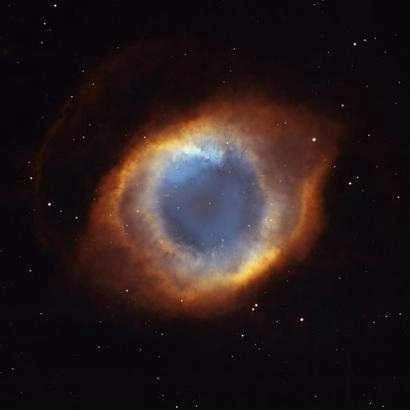
Fun to contemplate, no? Okay, this isn’t really a current event, though a friend just sent it to me today. This picture was posted on NASA’s “Astronomy Picture of the Day” website back on May 10, 2003. Internet folk have been passing it around ever since with the added notation above, and a follow-up that NASA refers to this as “The Eye of God”. Urban legend…or Net legend – this pass-around is one of those chain letter type things that resurfaces every now and again.
Here’s NASA’s official caption for the picture:
Explanation: Will our Sun look like this one day? The Helix Nebula is the closest example of a planetary nebula created at the end of the life of a Sun-like star. The outer gasses of the star expelled into space appear from our vantage point as if we are looking down a helix. The remnant central stellar core, destined to become a white dwarf star, glows in light so energetic it causes the previously expelled gas to fluoresce. The Helix Nebula, given a technical designation of NGC 7293, lies about 650 light-years away towards the constellation of Aquarius and spans about 2.5 light-years. The above picture is a composite of newly released images from the ACS instrument on the Hubble Space Telescope and wide-angle images from the Mosaic Camera on the WIYN 0.9-m Telescope at Kitt Peak National Observatory. A close-up of the inner edge of the Helix Nebula shows complex gas knots of unknown origin.
To put that in English…
The Helix Nebula is about 650 light-years from Earth. It’s a popular target for astronomers because it’s easily viewable through binoculars or telescope. The phenomenon above is real. The image, however, is not, at least not in the technical sense of the word “picture”. It is a computer-generated and enhanced mosaic based on nine individual photographs taken by both the Hubble telescope and the National Science Foundation’s telescope at Kitt Peak Observatory near Tucson.
Despite the resemblance to an eye in this image, the Helix Nebula is a spiral cylinder more than one trillion kilometers long. It points directly toward Earth and therefore looks like an eye to us, rather than the tube-like structure that it is. To the best of anyone credible’s knowledge, no one at NASA has ever referred to this in any official capacity as “the eye of god”. In fact, this phenomenon and similar ones are common enough that both professional and amateur astronomers have dubbed many object “the eye of god” over time.
Here is a non-composite photo of the Helix Nebula from NASA’s website (still vaguely eye-ish):

And, just because they can be really, really pretty, here are a couple more, respectively, the Catseye Nebula and the Wings of a Butterfly Nebula:
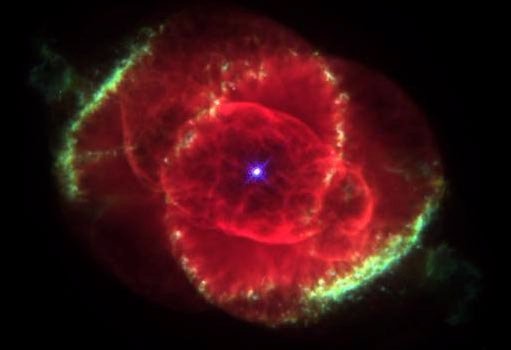
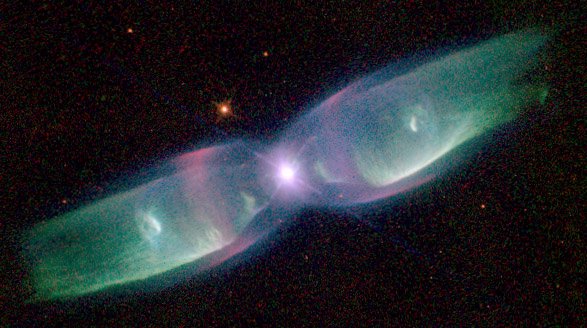
Gates?
 New York City is all abuzz about “The Gates”. For those of you who haven’t heard about it (I was away when it opened and didn’t know about it until a few days after returning), it is an “art” installation in Central Park. I place the word art in quotes because it is called as such by the artists, though I can find little to fit the description. If you can, imagine a large number (to paraphrase the Hitchhiker’s Guide to the Galaxy… a really, really, really large number) of roughly 20 foot high steel frames with shower curtains hanging from them (okay, actually there are 7,500 of them). Lining 23 miles worth of walkways in the park. Flapping in the breeze. Oh, did I mention they’re the color of a an orange prison uniform? (The artists refer to the color of saffron, but I’d throw out any saffron of that color.)
New York City is all abuzz about “The Gates”. For those of you who haven’t heard about it (I was away when it opened and didn’t know about it until a few days after returning), it is an “art” installation in Central Park. I place the word art in quotes because it is called as such by the artists, though I can find little to fit the description. If you can, imagine a large number (to paraphrase the Hitchhiker’s Guide to the Galaxy… a really, really, really large number) of roughly 20 foot high steel frames with shower curtains hanging from them (okay, actually there are 7,500 of them). Lining 23 miles worth of walkways in the park. Flapping in the breeze. Oh, did I mention they’re the color of a an orange prison uniform? (The artists refer to the color of saffron, but I’d throw out any saffron of that color.)
 I spent an hour or so wandering amidst this unfortunate use of materials (10.5 million pounds of steel, 60 miles of vinyl tubing, 1 million square feet of nylon fabric, plus all the associated nuts, bolts, etc., to hold it all together). The park was thronged with folks there to gawk, to marvel, to critique. One friend of mine said he got a visceral thrill from it. A woman I passed wondered what was to be done with all the steel and plastic after the installation ends (I do too… what does one do with more than 5000 tons of bright orange steel and several thousand bright orange shower curtains?). Don’t forget about the 1 millions swatches of specially made nylon fabric that the artists had commissioned to be given away on a first-come, first-served basis to visitors… figure most of those will end up in the landfill after a few years… months… weeks… days… In an op-ed by Ted Caplow, an environmental engineer, in the New York Times, he mused:
I spent an hour or so wandering amidst this unfortunate use of materials (10.5 million pounds of steel, 60 miles of vinyl tubing, 1 million square feet of nylon fabric, plus all the associated nuts, bolts, etc., to hold it all together). The park was thronged with folks there to gawk, to marvel, to critique. One friend of mine said he got a visceral thrill from it. A woman I passed wondered what was to be done with all the steel and plastic after the installation ends (I do too… what does one do with more than 5000 tons of bright orange steel and several thousand bright orange shower curtains?). Don’t forget about the 1 millions swatches of specially made nylon fabric that the artists had commissioned to be given away on a first-come, first-served basis to visitors… figure most of those will end up in the landfill after a few years… months… weeks… days… In an op-ed by Ted Caplow, an environmental engineer, in the New York Times, he mused:
According to the United States Department of Energy, the steel industry in this country consumes about 18 million B.T.U.’s of raw energy to produce one ton of steel. If the cast steel in “The Gates” is typical American steel, then making it has required 97 billion B.T.U.’s, an amount equivalent to the entire annual energy consumption – including that used to run cars, furnaces, air conditioners and home appliances – of nearly 500 New York state residents.
Energy for the steel industry is supplied in roughly equal thirds by coal, natural gas and electricity from the grid. Based on generally accepted rates of carbon dioxide emissions for these three sources, it appears that making steel for “The Gates” churned out 7,000 tons of carbon dioxide, equivalent to the combined output of about 1,600 average American cars for a year (carbon dioxide is viewed by most scientists as a threat to the global climate system). We would have to plant more than 200 acres of trees and grow them for 10 years to remove this carbon dioxide from the atmosphere. Central Park has an area of about 800 acres, but only part of this has trees; and the mature trees that dominate the park do not absorb carbon dioxide effectively, so we cannot look to the park to clean up the mess.
In terms of sheer mass, the amount of plastic in “The Gates” is dwarfed by the steel, but emissions of carbon dioxide, dioxins and other toxins from plastics manufacturing are also a concern. The plastic chosen for the supports, polyvinyl chloride, or P.V.C., is an increasingly controversial material that releases dioxins and other carcinogens to the air and water during manufacture (and possibly afterward). Polyvinyl chloride has been singled out as “the poison plastic” by Greenpeace and other environmental groups. We now have 60 miles of it in the park. Clearly, the squirrels were not consulted on this choice.
Is it art? Who knows. I could almost see that if viewed from the air I could, perhaps, find something artistic about it (see picture below). From the ground it was little more than an interesting feat of very basic engineering – interesting for its scope rather than its content.
The artists, Christo and Jeanne-Claude, have stated that it was all paid for by themselves and took them 26 years to create. Perhaps, perhaps not. The city seems to feel that it is bringing in a burst of needed revenue. Most likely true… on this last Sunday, a week after the installation, there still must have been several tens of thousands of tourists there to see it. It certainly is a revenue builder for some folks. Why wasn’t I the one to think of buying up yards of orange nylon (in varying shades, none of which matched the installation) and selling square yards of it for $20 a pop as one enterprising young man was doing? I didn’t come up with the orange ponchos (well, really more of pieces of nylon with a string tying two corners together… very cape-like) for $25 each either. Nor the t-shirts, nor sweatshirts, nor the orange soda sales.
Thankfully, there are those out there with a good perspective on it… I refer you to The Somerville Gates…
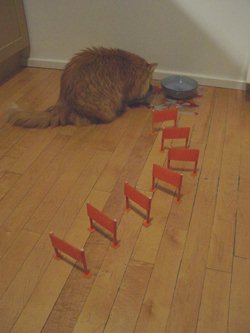
..or perhaps to The Crackers, far more intriguing to my mind.

I leave you with an excerpt from New York Magazine:
“Nobody speaks to Christo!” says his wife and collaborator, Jeanne-Claude, in her dramatic Parisian accent. “Christo is working seventeen hours a day on the drawings we must sell to pay for The Gates. Without these sketches, there will be no Gates!”
So every morning Christo climbs the stairs from the couple’s fourth-floor apartment to his fifth-floor studio. He works, standing, for several hours on wall-size drawings that illustrate the plans for The Gates, the enormous installation he and his wife have planned for Central Park, and which is scheduled to open in mid-February. Sometimes he moves to a table to work on one of six or seven smaller collages, all at various stages of completion. Or he spreads out a drawing on the floor and works, wearing gardener’s knee pads. “Sometimes he comes down to eat raw garlic, which he eats three times a day,” says Jeanne-Claude. “A total of one head of garlic a day, raw, like candies. With some yogurt. And sometimes a glass of soy milk. That takes him about three minutes. Then back to the studio.”
He leaves Jeanne-Claude downstairs to conduct interviews and schedule visits by collectors, several of whom now visit their studio each day. The works are priced by size: The small collages, measuring eleven inches by eight and a half inches, sell for $30,000; the wall-size drawings, at four and three quarters feet by eight feet, go for $600,000. The Gates, which is being financed entirely by the Christos, with not a penny of grants, city money, or donations, is budgeted at $20 million—which translates to a lot of collages, drawings, sketches, and models. “Nobody comes up here unless they are buying!” Jeanne-Claude says. “Are you buying?”
Democracy

In tribute to Johnny Carson, I merely reproduce one of my favorite pieces of his, sans commentary. When this was originally delivered on the air in 1991, The Battle Hymn of the Republic was playing in the background. You’ll have to imagine it…
What Democracy Means to Me
by Johnny CarsonTo me, democracy means placing trust in the little guy, giving the fruits of nationhood to those who built the nation. Democracy means anyone can grow up to be president, and anyone who doesn’t grow up can be vice president.
Democracy is people of all races, colors, and creeds united by a single dream: to get rich and move to the suburbs away from people of all races, colors, and creeds. Democracy is having time set aside to worship — 18 years if you’re Jim Baker.
Democracy is buying a big house you can’t afford with money you don’t have to impress people you wish were dead. And, unlike communism, democracy does not mean having just one ineffective political party; it means having two ineffective political parties.
Democracy means freedom of sexual choice between any two consenting adults; Utopia means freedom of choice between three or more consenting adults. But I digress. Democracy is welcoming people from other lands, and giving them something to hold onto — usually a mop or a leaf blower. It means that with proper timing and scrupulous bookkeeping, anyone can die owing the government a huge amount of money.
Democracy means a thriving heartland with rolling fields of Alfalfa, Buckwheat, Spanky, and Wheezer. Democracy means our elected officials bow to the will of the people, but more often they bow to the big butts of campaign contributors.
Yes, democracy means fighting every day for what you deserve, and fighting even harder to keep other weaker people from getting what they deserve. Democracy means never having the Secret Police show up at your door. Of course, it also means never having the cable guy show up at your door. It’s a tradeoff. Democracy means free television. Not good television, but free.
Democracy is being able to pick up the phone and, within a minute, be talking to anyone in the country, and, within two minutes, be interrupted by call waiting.
Democracy means no taxation without representation, and god knows, we’ve just about had the hell represented out of us. It means the freedom to bear arms so you can blow the “o” out of any rural stop sign you want.
And finally, democracy is the eagle on the back of a dollar bill, with 13 arrows in one claw, 13 leaves on a branch, 13 tail feathers, and 13 stars over its head. This signifies that when the white man came to this country, it was bad luck for the Indians, bad luck for the trees, bad luck for the wildlife, and lights out for the American eagle.
I thank you.
The Gay Bomb
 The Gay Bomb
The Gay Bomb
Don’t Ask, Don’t Tell. That’s our national military’s policy on homosexuality. (By the way, I was in ROTC back in college in the mid-70s, I told when asked, it didn’t stop them from admitting me to the program – though, of course, that was before the policy, it was during the “no way you’re getting in” era. I was also once interviewed by the CIA, originally for a position in psychological profiling, but then was offered a position in data analysis – they asked, I told, they still offered. Who knows?)
Regardless, the policy is clearly for our military, not our enemies:
“Category # 3: Chemicals that affect human behavior so that discipline and morale in enemy units is adversely affected. One distasteful but completely non-lethal example would be strong aphrodisiacs, especially if the chemical also caused homosexual behavior.”
This from the Wright Laboratory at Wright-Patterson Air Force Base in Ohio, part of a 1994 study paper entitled “Harassing, Annoying, and “Bad Guy” Identifying Chemicals. The paper came to light this week as a result of efforts from the Sunshine Project, a biological/chemical warfare watchdog group. According to the officer in charge of such things, neither this nor any of the other silly ideas in the paper were pursued, they were merely proposed and discussed.
There’s clearly not enough detail in the paper released to figure out things like: How did they plan to test this one?
“Conduct tests to determine safety/toxicity for humans, then conduct field trials to determine initial and lasting effectiveness in various climates and conditions….”
(Some commentators have suggested that San Francisco’s Castro district and New York’s Greenwich Village might have been test sites…)
If homosexuality is a combination of “nature and nurture”, as is generally believed, just exactly what sort of chemical was going to convert heterosexuals to homosexuals? Did someone really think that just by making soldiers super-horny (aren’t they already?) they would drop their weapons, stop listening to their orders, and jump each other in the foxholes… so to speak?
On the flip side of this, and in a clearly clairvoyant moment, Weekly World News reported way back in August of last year that:
“Extremist Muslim scientists are developing a bomb that turns anyone within a 30-mile radius of its blast into a homosexual, say U.S. Intelligence insiders.”
